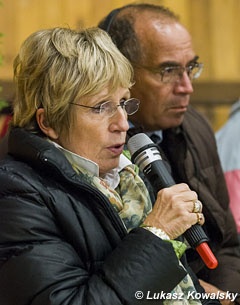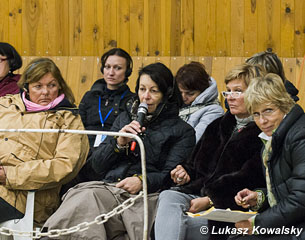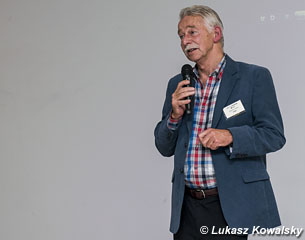
During the CDI 3* Zakrzow on 7 - 9 November 2014 the organizer of the competition, Lewada Riding Club, hosted the FEI refresher seminar with German judge Katrina Wüst as director. Eighteen FEI judges participated and additionally, 25 national judges from 11 different countries, travelled to Zakrzow for the seminar for national judges organized by European Equestrian Federation (EEF) at the initiative of Wojtek Markowski.
The EEF organized the seminar to help national federations with their judges' education programs. Zakrzow was the pilot event for this exciting initiative.The plan was to run the two seminars simultaneously, but as Mr. Markowski unfortunately could not attend for health reasons, the two seminars were run as one by Katrina Wüst, who stimulated the participants to "judge with feeling."
Katrina Wüst, 5* dressage judge and an experienced course director, tackled this unexpected challenge with grace and offered the participants three days full of inspiring knowledge and discussion.
For a great performance, riders need to have a good feeling on the horse, strong concentration on the basics and accuracy. Ms Wüst showed that to be a good judge, a similar approach has to be taken for judging. It is important to feel what you are judging and differentiate between “system errors” and momentary lapses of concentration that are not a reflection of the basic training.
An exciting part of the seminar was the segment about freestyles, or more precisely, taking the mystery out of freestyle judging. Riders were also invited to come and listen in - and those who did, went home with definitely a deeper knowledge of the structure and different elements the judges are looking for in a well-designed freestyle.
 The main focus was, of course, on the artistic side of the freestyle marks, especially the scores for Choreography, Degree of Difficulty and Music. Katrina Wüst proposed a structure of “5 pillars” for each of the marks.
The main focus was, of course, on the artistic side of the freestyle marks, especially the scores for Choreography, Degree of Difficulty and Music. Katrina Wüst proposed a structure of “5 pillars” for each of the marks.
For Choreography we looked at structure, originality, use of arena, balance and suitability for the horse. In all the aspects, a good freestyle should be a performance and in its structure, resemble any other visual art form such as a feature film or a play in the theatre. It should capture the audience from the entry and keep the viewers on their toes until the finish. It should have a good balance between the extended and collected movements, show beautiful symmetry but at the same time offer some surprises and unexpected or unusual solutions. The only art form that should not be incorporated in a freestyle is the circus!
The Degree of Difficulty should be assessed, considering the difficulty of movements, transitions, combinations, lines and repetitions. The judge should put themselves in the rider’s seat and not forget that certain unusual transitions and combinations are actually very difficult (for example halt to passage or extended trot to collected walk), and that is why enough credit should be given to those if performed effortlessly. Risks taken should be always in accordance with the ability of the horse.
For a high score in Music, it should fit all paces and transitions, underline various movements, be suitable for the type of rider and horse, all pieces should be brought together by a similar style, genre or theme – and last but not least, evoke positive emotions in the audience. The music should not just fit the footfalls, but also tell a story, highlight the best and hide the weaker movements of the horse.
All the artistic marks are connected with each other and cannot be viewed separately.
Ms Wüst had prepared a lot of video clips to illustrate all the different aspects and situations of freestyles, both brilliant and not-so-good, which made it fun and thought-provoking at the same time.
Here are some thoughts to remember, think about and take home from the seminar:
 When looking at a movement, start with the rhythm and quality of the pace
When looking at a movement, start with the rhythm and quality of the pace
- Demand accuracy and reward accurately ridden lines
- Be more forgiving on “non-system” errors
- High marks rewarded appropriately increase the credibility of the judging system
- Always look at the “whole picture”
A photo report from the refresher seminar at the bottom of this page.
by Eva Maria Vint-Warmington - Photos © Lukasz Kowalski
Related Links
Photo Report: 2014 Polish International Dressage Season Concludes with 2014 CDI Zakrzow
FEI to Hold Refresher Seminar and Steward Promotion Course in Poland
FEI Judges Refresher Course at 2013 CDI Sydney
Judging Refresher Course in Brazil with O-judge Mariette Withages